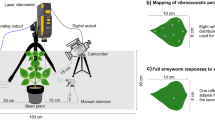Abstract
Locomotory behaviour of 1st instar Helicoverpa armigera is influenced by a complex of micro-attributes, the leaf “environment”, comprising odours, wax chemistry, trichomes and grip texture. Larval movement speeds on leaves of different types varied more than eight fold. On garden pea, Pisum sativum, there is a hierarchy of stimuli perceived by larvae resulting in differing behavioural responses. Light and angle are paramount in responses to micro-environment. These influence responses to local stimuli. Experiments in darkness produce different responses from those under laboratory light. In darkness, on horizontal surfaces as found for most leaves, preference for leaf surface is driven by micro-environment associated with leaf waxes. Larvae prefer the abaxial surface. In light, on horizontal surfaces, larvae seek enclosed spaces and foray under leaf surfaces. They wander more openly in the dark. Such information is important in building a model of larval behaviour and predicting behaviour on differing plant architectures.







Similar content being viewed by others
References
Bernays EA, Chapman RF, Woodhead S (1983) Behaviour of newly hatched larvae of Chilo partellus (Swinhoe) (Lepidoptera: Pyralidae) associated with their establishment in the host-plant, sorghum. Bull Entomol Res 73:75–83
Bernays EA, Woodhead S, Haines L (1985) Climbing by newly hatched larvae of the spotted stalk borer Chilo partellus to the top of sorghum plants. Entomol Exp Appl 39:73–79
Eigenbrode SD (2004) The effects of plant epicuticular waxy bloom on attachment and effectiveness of predatory insects. Arthropod Struct Dev 33:91–102
Eigenbrode S, Espelie KE (1995) Effects of plant epicuticular lipids on insect herbivores. Annu Rev Entomol 40:171–194
Eubanks MD, Nesci KA, Petersen MK, Liu ZW, Sanchez HB (1997) The exploitation of an ant-defended host plant by a shelter-building herbivore. Oecologia 109:454–460
Gniwotta F, Vogg G, Gartmann V, Carver TLW, Riederer M, Jetter R (2005) What do microbes encounter at the plant surface? Chemical composition of pea leaf cuticular waxes. Plant Physiol 139:519–530
Khan ZR, Ward JT, Norris DM (1986) Role of trichomes in soybean resistance to cabbage looper, Trichoplusia ni. Entomol Exp Appl 42:109–117
MacLellan C (1973) Natural enemies of the light brown apple moth, Epiphyas postvittana, in the Australian capital territory. Can Entomol 105:681–700
Mueller T, Fagan WF (2008) Search and navigation in dynamic environments—from individual behaviors to population distributions. Oikos 117:654–664
Müller C, Hilker M (2001) Host finding and oviposition behavior in a chrysomelid specialist—the importance of host plant surface waxes. J Chem Ecol 27:985–994
Müller C, Riederer M (2005) Plant surface properties in chemical ecology. J Chem Ecol 31:2621–2651
Perkins LE, Cribb BW, Hanan J, Glaze E, Beveridge C, Zalucki MP (2008) Where to from here? The mechanisms enabling the movement of first instar caterpillars on whole plants using Helicoverpa armigera (Hübner). Arthropod Plant Interact 2:197–207
Perkins LE, Cribb BW, Hanan J, Zalucki MP (2009) The role of two plant-derived volatiles in the foraging movement of 1st instar Helicoverpa armigera (Hübner): time to stop and smell the flowers. Arthropod Plant Interact 3:173–179
Perkins LE, Cribb BW, Hanan J, Zalucki MP (2010) The movement and distribution of Helicoverpa armigera (Hübner) larvae on pea plants is affected by egg placement and flowering. Bull Entomol Res (in press)
Potting RPJ, Vermeulen NE, Conlong DE (1999) Active defence of herbivorous hosts against parasitism: adult parasitoid mortality risk involved in attacking a concealed stemboring host. Ent Exp Appl 91:143–148
Ramachandran R, Khan ZR (1991) Modulation of phototactic behaviour of first-instar larvae of rice leaf roller by plant factors. Entomol Exp Appl 58:149–157
Selvanarayanan V, Narayanasamy P (2006) Factors of resistance in tomato accessions against the fruit worm, Helicoverpa armigera (Hubner). Crop Protection 25:1075–1079
Sharma HC, Sujana G, Manohar Rao D (2009) Morphological and chemical components of resistance to pod borer, Helicoverpa armigera in wild relatives of pigeonpea. Arthropod Plant Interact 3:151–161
Shimizu I, Kato M (1978) Loss of phototaxis in silkworm larvae after smelling mulberry leaves and recovery after electroconvulsive shock. Nature 272:248–249
Suckling DM, Ioriatti C (1996) Behavioral responses of leafroller larvae to apple leaves and fruit. Entomol Exp Appl 81:97–103
Teakle RE, Jensen JM (1985) Heliothis punctiger. In: Singh P, Moore RF (eds) Handbook of insect 672 rearing, vol II. Elsevier 673, Amsterdam, pp 313–322
Yang G, Wiseman BR, Isenhour J, Espelie KE (1993) Chemical and ultrastructural analysis of corn cuticular lipids and their effect on feeding by fall armyworm larvae. J Chem Ecol 19:2055–2074
Zalucki MP, Daglish G, Firempong S, Twine P (1986) The biology and ecology of Heliothis armigera (Hübner) and H. punctigera Wallengren (Lepidoptera: Noctuidae) in Australia: What do we know? Aust J Zool 34:779–814
Zalucki MP, Murray DAH, Gregg PC, Fitt GP, Twine PH, Jones C (1994) Ecology of Helicoverpa armigera (Hübner) and H. punctigera in the inland areas of eastern Australia: larval sampling and host plant relationships during winter/spring. Aust J Zool 42:329–346
Zalucki MP, Clarke AR, Malcolm SB (2002) Ecology and behaviour of first instar larval Lepidoptera. Ann Rev Entomol 47:361–393
Acknowledgments
We gratefully acknowledge Dr Sanford Eigenbrode, University of Idaho, for providing plant varieties and discussion on epicuticular wax bioassays. Assoc. Prof. Christine Beveridge and Kerry Condon, The University of Queensland, ARC Center of Excellence for Integrative Legume Research are thanked for providing P. sativum seed and advice on plant matters. Dr. Dave Murray and Sue McLean, Queensland Department of Primary Industries and Fisheries, Toowoomba, Australia provided H. armigera eggs. This research was supported under the Australian Research Council’s Discovery Projects funding scheme (DP0666109).
Author information
Authors and Affiliations
Corresponding author
Additional information
Handling Editor: Joseph Dickens.
Rights and permissions
About this article
Cite this article
Cribb, B.W., Hanan, J., Zalucki, M.P. et al. Effects of plant micro-environment on movement of Helicoverpa armigera (Hübner) larvae and the relationship to a hierarchy of stimuli. Arthropod-Plant Interactions 4, 165–173 (2010). https://doi.org/10.1007/s11829-010-9097-0
Received:
Accepted:
Published:
Issue Date:
DOI: https://doi.org/10.1007/s11829-010-9097-0




